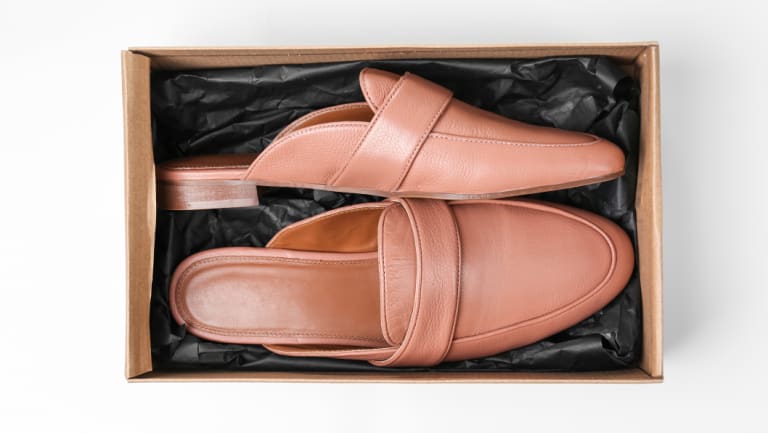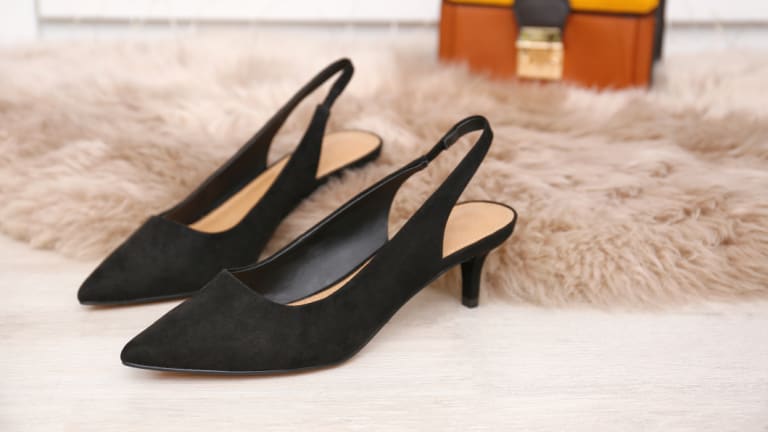While we make so much fuss about children's school shoes, the footwear adult women spend most of their time in tends to be less heavily scrutinised. Your typical women's shoe is often flimsy, occasionally blister-inducing and, concerningly, can be capable of causing some serious damage to your foot.
So, with new season styles now in stores – and the weather too warm for your trusty ankle boots (alas) – which shoes are best for regular wear over the summer months? Sydney podiatrist Charlotte Bodell gives her verdict.
Mules are not a good option for daily wear.Credit:Shutterstock
Mules
Mules in every style and hue are certainly this summer's default. Gucci's black Princetown mules (with the gold bar on the front – you know the ones) have trickled down from Zara, to Kmart, to the feet of every woman looking for a slightly casual corporate shoe.
But, what effect does wearing a shoe with no back support have on your feet? Quite a large and unpleasant one, says Bodell, who does not recommend mules as an everyday shoe.
"What you will definitely get is hammered toes from [your foot] clawing forward, corns on the apex of your toes [underneath the toes], and you will get corns on the tops of your toes, because the shoe is tapering down."
There is also a slightly more cosmetic problem which can result from the frequent wearing of mules, which Bodell says she has been observing in her clients since the '90s throwback shoes reached mainstream popularity last summer.
"Because there's no back to the shoe, the fat pad of the skin is hanging over the heel itself, and people are getting hard skin and cracks on the heel," she explains, adding there is an easy fix.
"Get a foot file and file the skin off, then put some heel balm cream on a nighttime with a pair of socks."
Slingbacks
Throw a strap around the back of a mule and you have the slingback. Often seen with a flat or a kitten heel, slingback styles are everywhere.
"It's good that there is a strap, because it's keeping the shoe on," Bodell says, although there is a catch.
The slingback is a slightly better option for daily wear, provided the fit is right.Credit:Shutterstock
"For [the strap] to stay on, you need to push your foot forward in the shoe. So, if the shoe is a little bit too small for you, your toes are going to be crunched up, and hammered, and curling under."
If that happens, you can end up clawing onto the front of the shoe with your toes, just like in a pair of mules. The key is to make sure your slingbacks are a nice fit.
Pointed-toe shoes
Shoe trends tend to oscillate between blunt and pointy (a helpful quirk to ensure we part with our money regularly and unnecessarily). A scan of the shops reveals it's currently pointy season. Unfortunately, this is not a season known for comfort.
"You're more likely to get the bunion formation on your big toe joint," Bodell warns of shoes which make your toes squish close together.
In more extreme cases, putting your non-triangular foot in a triangular shoe can lead to a painful condition called Morton's neuroma, which feels like you permanently have a rock stuck under the ball of your foot.
"You've got nerves on your metatarsal joints," Bodell explains. "And, when they're pushed together you get fibrous tissue that forms on the nerves. Then, when you squeeze the foot, it brings on a nerve pain."
Ouch.
Kitten heels
We might think that heels are worse than flats for our feet, but Bodell says a slight heel, like a kitten heel, can actually be better than a totally flat shoe.
"It helps the ankle joint get into position," she says. "If you have tight calves, it helps to take the pressure off your arch and off your calf."
However, the stiletto style of most kitten heels on the market is not ideal.
"They can be quite unstable; you're better off with a block heel. And, if you're prone to rolling your ankle, these will increase the likelihood of that."
Plastic shoes
"But, what about my favourite see-through plastic shoes?" I hear literally no one ask.
Probably popularised by Kim Kardashian (who wore high, transparent plastic boots from her husband Kanye West’s fashion line two years ago, prompting a number of knock-offs), shoes with transparent plastic uppers are around again this summer. And, as will probably not shock, they are neither comfortable nor sanitary.
"[The plastic] doesn't bend and it doesn't soften, so if you're using those shoes and it's hot in the afternoon, your feet will swell and you will get blisters," Bodell says, adding that "all the moisture and the sweat" can also create a nasty fungal situation.
The ideal summer workday shoe
So, which shoes should you be wearing this summer?
Bodell recommends a heel somewhere between 2-5cm high, ideally in the 2-3cm range.
"If you're wearing a flat shoe, the mid foot will roll through because you haven't got any cushioning or support on your arch," she says.
A strap across the front of the foot is also a good feature ("so you don't have to do any clawing"), while arch support and a little platform on the front should also help your feet wear a style for a long period.
"You want a little platform on the front to give you a bit of padding on the ball of your foot, which should prevent any sort of stress fractures if you're prone to pounding the streets."
But, if you are pounding the streets – either on your commute or your lunch break – Bodell says the best thing to do is to bring a pair of sneakers.
"There are lots of trendy ones out there now," she says. "You don't need to wear your boring trainers. But, if you're going to walk longer than 15-20 minutes in the morning, do not wear your regular strappy shoe you would wear to work: you will get problems."
Source: Read Full Article


